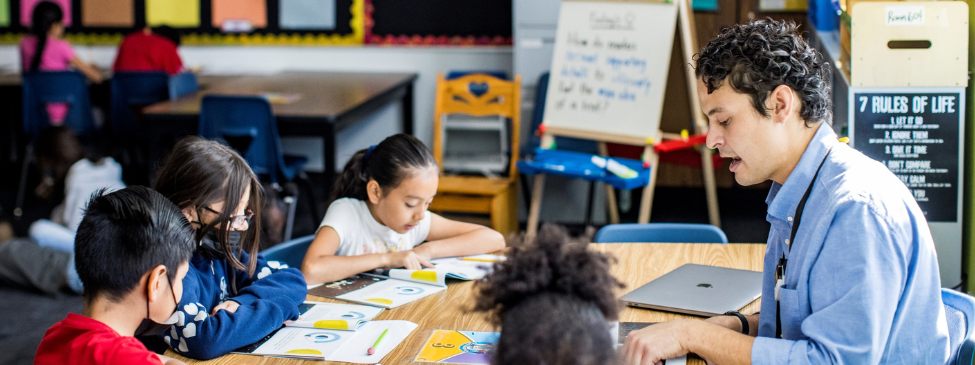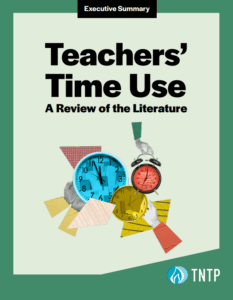In the nearly four years since the pandemic turned education on its head, we have collectively learned more than we could have ever imagined. Educators have been at the center of these profound shifts, never waiting around for a “magic bullet” and instead leading schools and classrooms to persist through obstacles that have reshaped the educational landscape.
But what sets this era apart is not just the hurdles we’ve faced; it’s the remarkable innovations that have unfolded. Grow your own teacher pathways, high-impact tutoring, and community driven learning pods have emerged as bright spots across the country. These solutions have brought about much-needed progress in the face of growing educator shortages and historic declines in student achievement.
It’s in this context of transformation that we’re faced with a fundamental question about the future of PK-12 education: How do we build upon the knowledge and innovations we’ve gained and create better, bolder solutions that empower educators to put all students, particularly those furthest from opportunity, firmly on the path to academic, social, and economic mobility?
Introducing TNTP’s Workforce Design Framework
To help address this crucial question, we are thrilled to introduce our new Workforce Design Framework, which has codified our forward-thinking perspective into a holistic approach to how we can effectively support every educator in bringing their vision for students to life. We also extend heartfelt appreciation to the numerous partners who contributed their insights and expertise to the development of this framework.
The Workforce Design Framework brings together the twin engines of educational progress: academics and talent. By attracting, supporting, deploying, and retaining the talent needed to achieve the student experience every system and school envisions, we can bridge the gap between the challenges we face and the brighter educational future we envision. In TNTP’s more than 25 years of experience supporting schools, systems, and communities with both talent and academic projects, we’ve seen that the most successful projects are those that center students, and that creating coherence across all of the systems that support the student experience is essential.
While young people are at the center of this framework, it is crucial to emphasize the indispensable roles educators play in achieving the progress we collectively seek. For educators, particularly those from underrepresented communities in the education workforce, the imperative is clear: to ensure they are respected, affirmed, and in sustainable, well-regarded, and well-compensated long-term careers. In particular, we want schools and systems to use this framework as a way to approach creating better experiences for educators of color, and that this enables us to build and maintain a workforce that matches the racial diversity of the students we serve. Our hope is that this framework becomes a cornerstone of support for both young people and educators, making it possible for us to design an education system capable of lifting every student and family.
A Closer Look at the Framework
Before tackling workforce and talent, schools and systems must articulate a clear vision for excellent instruction and the experience they want every student to have. This vision serves as a unique north star, the benchmark against which we measure our success and guides decision-making. See Learning Acceleration for All for guidance on this vision-setting.
The framework begins with building an asset-based, nuanced, and rich 360-degree view of the community and stakeholders a system or school serves. This means gaining a deep understanding of the hopes and aspirations of young people and their families, educators, and key data that can provide the fullest possible picture. This data can include student performance, workforce metrics, community demographics, and the invaluable perspectives of key stakeholders such as educators, students, and caregivers. Using both current and projected data allows predicting and planning for the evolving needs of our school communities.
With this comprehensive understanding in hand, the framework guides systems and schools to consider how they can design and implement educator experiences that are supportive, affirming, and rewarding – and enable them to realize the vision for students. This strategic core of the framework helps all individuals within the educational ecosystem to maximize student success:
- Pathways to Enter: How can schools and systems strengthen pipelines while increasing students’ access to effective, diverse educators?
- The Right Workload: How can schools and systems change educator roles to deliver a better experience for students and teachers?
- Reasons to Stay: How can schools and systems cultivate supportive, thriving cultures that foster educator development and promote retention of top talent?
This strategic core encompasses both tried and true evidence-based practices, such as early hiring practices and regular retention conversations, as well as more innovative practices, like designing educator roles that flexibly maximize each individual’s unique strengths and goals. These creative ideas emerge best when we’re thinking about talent and academics together and how they intersect to support stronger experiences for all.
Next the framework turns to implementation: how can schools and systems increase collective agency to maximize efficacy and impact? This section helps schools and systems identify and address key capacity, policy, and leadership considerations.
For more detailed guidance, see our complete guide to the Workforce Design Framework.
The Workforce of Tomorrow Starts Today
TNTP is energized and ready to collaborate with schools, systems, and other organizations in exploring the Workforce Design Framework and leading a bold vision for progress. Together, we can design a future where every young person’s educational experience enables them to access multiple pathways to academic, social, and economic mobility.
To learn more about how TNTP can support your work, contact us.








